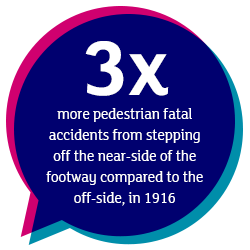
Centenary
Since RoSPA's early days improving road safety during the black-outs of the First World War, we have existed for a simple reason – to stop the needless devastation and heartache caused by accidents.
As events around the globe commemorated the centenary of the First World War, we were also proud to mark our 100th anniversary during 2016/17.
We looked back over a century of changing attitudes to safety, our groundbreaking campaigns and the successes achieved.
But we also remembered those who had died, and their loved ones left behind, as well as those whose injuries had changed their lives irrevocably.
How it all began – "the rule of the footpath"
 First World War black-out conditions had caused concern about pedestrian deaths resulting from people stepping into the path of vehicles approaching them from behind. It was felt that something needed to be done and a decision was taken to elect the London "Safety First" Council.
First World War black-out conditions had caused concern about pedestrian deaths resulting from people stepping into the path of vehicles approaching them from behind. It was felt that something needed to be done and a decision was taken to elect the London "Safety First" Council.
At the time, it was customary for pedestrians to walk on the right-hand side of footpaths, which meant that those walking closest to the traffic had their backs to approaching vehicles.
Among various options, consideration was given to changing the side of the road on which vehicles drove so they kept to the right. But this was ruled out due to the existing design of vehicles and road infrastructure, opposition from drivers, the need for horses to be re-broken and drivers to be retrained and the associated costs and confusion that would be incurred from all of the above.
Instead, it was decided that there would be less inconvenience and lower costs from requesting that pedestrians kept to the left-hand side of footpaths – meaning those closest to the traffic walked facing oncoming vehicles – and Richmond Borough Council became the first area of London to display notices encouraging this.
As the practice was adopted more widely, the results were seen immediately, with a 70 per cent decrease in the number of 'near-side' fatal accidents between 1916 and 1917.
And so began a century of safety campaigning, sometimes bold and public-facing and sometimes quiet and behind-the-scenes, to change attitudes and, where appropriate, legislation to save families from the anguish and heartache that serious accidents cause.
Visit our timeline